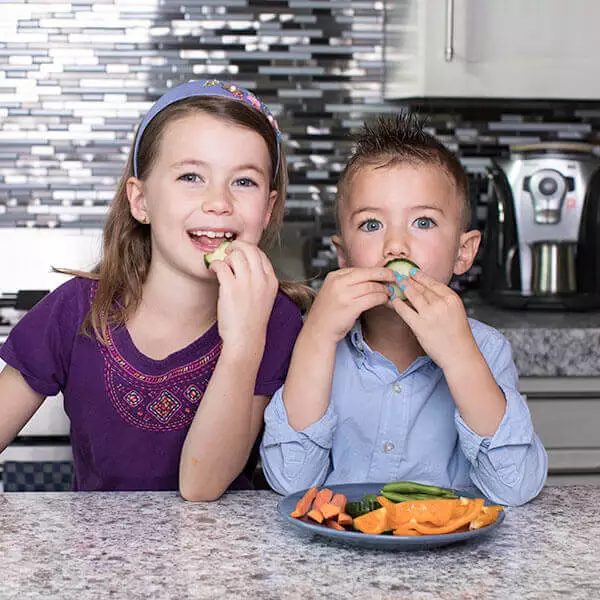
The ultimate guide to getting your child to try new foods for parents
WELCOME TO DINNERTIME WITH A PICKY EATER…
You dig to the bottom of your energy barrel to put a tasty-enough dinner on the table again tonight. Only to hear “yuck” from your kids. They won’t even touch it! ?
You scrape the perfectly good food from your child’s plate into the trash. Just as she asks for a snack. GRRRR
Ever wonder when the pickiness will end? You’re not alone – up to 1/2 of kids experience picky eating. I’ve been there too!
And there’s so much conflicting advice about how to deal with picky eaters. My doctor told me to give my daughter whatever she wanted. Or maybe you’ve heard they will eat when they’re hungry so let them starve. Or bribe them with dessert. What is the right thing to do?!
As a dietitian and a mom of 3 myself, I’ve created this guide to teaching your picky eater to try new foods. We’ll cover why your child might be picky, your roles and their roles in feeding and food play and therapy. Here we go!
Why is your child a picky eater?
The first step is determining why your child is a fussy eater. As Kay Toomey, creator of the Sequential Oral Sensory program, says: “When children don’t eat, something is going on in their body.” And we have to be smart enough to figure out what that is.
If an underlying physical cause goes untreated, behavioural interventions will have very limited success. Here are some possible reasons why your child is fussy with food:
- Developmental stage
The first reason your child might be a picky eater is their normal developmental stage. Generally, around 18 months, children start to develop more of a sense of independence.
They practice saying “no.” They want to do things on their own. And whether or not they eat is one of the few things that a toddler has control over.
After a year of age, growth slows down. So they don’t need as many calories per kilogram of body weight anymore. This leads to a decreased appetite. So your 18-month-old may eat less than when they were ten months old. That worries parents, but it’s normal.
Food neophobia (or fear of new foods) can kick in as well. This was possibly a protective mechanism a long time ago, to protect against poisoning!
- Genetics
If you or the other parent were picky eaters, there’s a good likelihood that your child will be a picky eater.
This doesn’t tend to be something that we screen our potential partners for! It’s payback for the grief you gave your parents! If you’ve personally experienced how difficult it can be for to try new foods, at least you (or your spouse!) can have some empathy.
- Oral motor weakness:
Your child may physically have difficulty moving food around in their mouth due to a weak bite, tongue or cheek muscles. Or maybe a tongue tie wasn’t addressed.
l cover many red flags for oral motor weakness in my End Picky Eating course. But one simple warning sign is that your child avoids meat and hard fruit or veggies as they’re harder to eat. The good news is that there are exercises to improve oral motor control if this is a concern.
- Sensory Sensitivity
Eating is the most difficult sensory activity we do. We have 8 different sensory systems:
- Touch
- Sight
- Sounds
- Smell
- Taste
- Proprioception
- Vestibular
- Interoception
People can be over-responsive (extra sensitive…called sensory avoiders) or under-responsive (less sensitive…called sensory seekers) in one or more of these senses.
For example, a child who is touch over-responsive may prefer certain food textures (usually crunchy) & “pre-chewed” (processed) foods. A young child may finger splay when they touch a wet/slimy texture like to wipe clean and prefer eating with utensils.
For more signs your child is over or under-responsive in one or more of these senses, check out my short TikTok video here.
Again, some more good news is that sensory exercises can be done to decrease sensory sensitivity, which I’ll discuss more later in this blog.
- Physical pain:
It may hurt to eat. Therefore your child may become conditioned not to eat. There are many reasons for this:
- Reflux (when stomach acid comes back up into the esophagus and throat after eating)
- Food allergies
- Cavities
- Constipation
- Nutrient deficiencies:
Your child could be deficient in nutrients that can affect appetite. Like iron or zinc. Iron deficiency can lead to both slow growth and a low appetite, which tends to be a negative cycle. This is common and occurs in about 10% of kids.
- A broken Division of Responsibility
The final (and most common) reason that your child is picky is behavioural. And it may be behaviour on your part. Which is actually good news! Because once you know that your actions are making the situation worse, you can change.
In Ellyn Satter’s Division of Responsibility in feeding, caregivers have roles in feeding, and children have roles in eating. And if you can follow these roles, your children will be less likely to be picky eaters and less likely to struggle with disordered eating.
I’ll break it down next…first, if you’d like to stop being a short-order cook so that your family can all enjoy the same meal. register for my free webinar called “How to teach kids to try new foods without yelling, tricking or bribing” click here.
Stop short-order cook syndrome
Parents are responsible for what foods are offered when it comes to following the Division of Responsibility. However, the child is often controls this rule instead.
Short-order cook syndrome happens when you offer your child food, and they don’t want to eat it. So you make their ‘backup food’ or their favourite food. Then you get stuck making two meals because you know your child will not eat your food.
And I see it happening even from starting solids when mom brings out a banana after the child doesn’t eat dinner. Because bananas are the favourite and baby will always eat a banana. That quickly turns into a toddler who only eats chicken fingers and fries.
This happens because the child knows they can get away with it. Why would your kid branch out and try new foods if they know that they can get Kraft Dinner?
And because you’re worried that your child won’t get enough calories or nutrients, or they’re not going to grow to their potential if you don’t make the food they will eat. Or that they’ll wake up in the middle of the night hungry!
But your role is to offer what the child eats and not to cater. It’s too much work to make separate meals, especially if you have more than one kid. It perpetuates picky eating, and you don’t need to do it.
But I hear you….”If I don’t cater to my child, he will starve….”
ALWAYS OFFER A FAMILIAR FOOD
One way to avoid your child going to bed hungry is to have at least one food on the table that your child can comfortably eat. Some people call this “safe” food. If your child is truly hungry but anxious about trying new foods, they can eat something without going hungry.
Often, a “safe food” is a glass of milk and a carbohydrate. Because carbs are soft, easy to eat and plain, for example, if you have pasta with meat sauce and a salad, the familiar food might be plain pasta.
Or if you’re serving meats and veggies, offer buns with butter as the familiar food. Other kids may like cucumber or cheese. This food is served to the whole family, and not just the picky child.
Again, I hear you……” but my child will only eat the buns….how can he live on just buns?!” It’s your choice what foods are offered, so rotate through their safe foods for more variety. And a child that is comfortable at the table and isn’t pressured to eat will be more likely to try new foods eventually.
Make Food Easier to eat
Also, consider your child’s preferences and eating skills without catering to them. Meat and vegetables are often foods that kids refuse. These food groups are not the tastiest and are more difficult to eat regarding oral motor skills (as they’re so hard).
Here are a few tips to make these food groups more appealing:
Tips to make VEGGIES easier to eat:
– try veggies cut shaped like a chip or fry (use a mandolin to make ‘chips’: sweet potato, parsnip, beet)
– roast veggies to bring out the sweetness
– try raw, frozen, cooked to mushy, mashed, and many different forms. Freeze-dried or frozen are often easiest to eat if your child is sensory sensitive (the texture doesn’t change as much as fresh)
– serve with dips to add flavour (hummus, yogurt dip or Ranch)
– serve veggies when hungriest (ex as an ‘appetizer’ or after school)
Tips to make MEAT easier to eat:
– slow cook or pressure cook meat so it’s tender
– ground meat is also tender (meatballs, meatloaf, meat sauce)
– add sauce to make meat more flavourful and tender (ex. BBQ sauce)
– try a crispy coating like chicken or fish fingers (easy to grab & sensory kiddos like a crunchy coating).
– dips are ok (ex. ketchup)
Is your child sitting on an adult’s chair?
Back to the Division of Responsibility. Another one of your roles is where your child eats. Ideally, at the family table, in a supportive seat.
I know everybody’s family situation is different. Maybe you’re a single parent, or your partner works away, so you can’t have the whole family join each dinner. Even if it’s just you and your children, or at breakfast or lunch…..that counts too.
Family meals offer amazing benefits as your child gets older. Adolescents who have family meals a couple of times a week not only get better nutrition but do better in school, and they’re less likely to be involved in risky activities like drugs and have better self-esteem. Start family meals as young as you can!
Another benefit of eating at the table for the little ones is it’s safer instead of eating while running around or in the car. It takes a lot of coordination and concentration to eat. And all of our muscles to chew and swallow. It’s a choking risk if not properly seated when eating.
Also, you’re a role model, especially if they have oral motor challenges. Babies and toddlers watch you and learn how to eat! And the more your kids see you eat different foods, the more comfortable they will get with eating these foods.
Regarding chairs, we want the child to be seated with the tray or the table between their nipple height and belly button. And this is often missed – feet supported. Not only do supported feet decrease the distraction of swinging legs, but they also help support the whole body and make chewing and eating easier.
You can learn more about the importance of a supportive seat when eating and how to modify your chairs here.
Stop the constant snacking: Close the Kitchen
Your final role in the division of responsibility is when your child eats. This includes structured meal and snack times rather than constantly snacking.
This is especially for picky eaters or small children, for the parents want them to eat as much as possible throughout the day. So they follow the kids around with snacks. And the child has a bite here and there.
But the problem is your child never experiences hunger or fullness. A bite here and there takes the edge off their appetite, and when they come for a meal, they’re not hungry. Constantly snacking throughout the day is also bad for their teeth.
So try a “Kitchen is Closed” rule. If your child asks for a snack between meal and snack times, you can say, “The kitchen is closed.” They can have water between meals but nothing else (including milk). This can be flexible if you think they’re truly hungry – but not if dinner is ready in 5 minutes!
The amount of time between snacks and meals will depend on your child. We want them to get to the point where they have an appetite come meal or snack, but they’re not at the meltdown-hangry stage.
About two to three hours between eating will be appropriate for most kids. As they get older, they can probably go three to four hours. But that depends on your child. I like to eat every two or three hours, too, so I wouldn’t expect my kids to go five hours between eating.
An example schedule could be:
- breakfast 7:30 AM
- mid-morning snack 10:00 AM
- lunch 12:30 PM
- afternoon snack 3:00 PM
- dinner 5:30 PM
- optional bedtime snack at around 7:30 PM
Whether you offer an evening snack depends on when you ate dinner and when your child goes to bed. Ellyn Satter calls this the evening snack, the “rescue snack.” Serve it to everyone regardless of whether dinner was eaten.
Bedtime snack doesn’t have to be reserved dinner but doesn’t have to be your child’s favourite either. Make the snack boring but nutritious. Like peanut butter or cereal and milk. Your child can still get nutrients from that and have a little bit in their tummy before bed.
Let your child decide how much to eat – without pressure
Your child’s only job is to decide how much to eat of the foods you’ve offered them at meal or snack time. Without you begging, bribing or rewarding…
The vast majority of parents use pressure, which can take many different forms you may not recognize. Ask yourself, “Why am I saying this to my child?” If it’s to get your child to eat more or eat something that they wouldn’t choose on their own, it’s pressure.
Pressure can look like:
- Praise: “I’m proud of you for trying that new fruit,” clapping, sticker chart, “What a big boy or girl.” Our kids shouldn’t eat for approval but because they’re hungry.
- Guilt: “I put a lot of work into dinner; it makes me sad that you won’t try it.” Or: “Your big brother’s eating it.” Or: “But you’ve eaten this before!”
- Bribes: candy, stickers, extra video game time, or dessert only after eating a certain food or certain amount. What these bribes are telling your child is the food they have to eat is yucky and puts the dessert/bribe on a pedestal. And the bribe becomes even more desirable. Not our desired outcome!
- Some feeding therapy: Some non-responsive feeding therapy methods, like Applied Behaviour Analysis, use forceful feeding tactics. Like forcing the child to kiss, lick or taste a food. Or “non-removal” of the spoon. This certainly doesn’t encourage anyone to enjoy eating.
- Nutrition education: “Popeye ate spinach; he’s strong,” “This is good for you.” Or “You need more protein.” These messages often go over your kid’s head and can be harmful.
Many research studies show that higher pressure to eat leads to lower levels of child intake and weight and higher levels of pickiness. So, pressure totally backfires. And makes meals unpleasant for everyone. Stopping the pressure takes practice, but it’s worth it!
Food play and positive feeding therapy
To review so far….implementing the division of responsibility is the basis for any child and family. Now, if your child has sensory or oral motor issues, activities can be done that will help them expand their food selection.
It’s important to make any food play or exercises fun and pressure-free. It can help to work with an occupational therapist specializing in feeding or a healthcare professional trained in the Sequential Oral Sensory method (SOS) or food chaining to implement feeding therapy or a food play plan at home (like me!).
In SOS therapy, the child is presented with a piece of food, one at a time to play with. Sensory properties link all foods; activities help work them up the ‘steps to eating.’ From being present with food to interacting with it, smelling, touching, tasting and eating it. Here’s an example of what SOS feeding therapy can look like. And for those over age 6+, I demonstrate the SOS “Food Explorer Program” with my son here.
Food Chaining is another way to encourage children to try new food. It takes a favourite food and a goal food and adds foods in between as a “chain.” All foods are similar in that there’s just one sensory property that’s different (like colour, shape or texture). I have a free guide including five food chaining examples here: How to use nuggets and fries to teach your kids to try new foods.
You can start easily at home with many different food play activities that aren’t “therapy.” Messy play will help your kids desensitize to different textures, which will help them when trying new foods!
Here are some sensory play ideas to help picky eaters:
Sensory bins
Start with dryer textures like dry pasta and move up to wetter ones like cooked pasta. If you can get their whole body involved, even better. Add shaving foam into an empty bathtub to play! And walk around on grass and sand barefoot in the summer. There are lots of great ideas on Pinterest.
Cook with your child
Creating meals in the kitchen gives kids a sense of pride and ownership of the food. Your child will be likelier to try a new food they helped make.
Many children don’t like the feel of certain textures or getting messy if they’re sensory sensitive. Cooking with your child exposes them to foods they typically avoid at mealtime. But it’s not mealtime…..so there’s no pressure to eat.
As with messy play, cooking gives your child extra exposure, and they may be more willing to touch these ingredients that they normally wouldn’t at the table.
Some ideas to get kids in the kitchen:
Toddlers:
- gather the ingredients out of the fridge and pantry for a recipe,
- gather the spoons, the bowls, measuring cups,
- add toppings to a pizza,
- stir muffin batter
- whisk eggs,
- wash fruits and vegetables.
Elementary and up:
- read the recipes,
- peel fruits and veggies,
- shred cheese,
- start cut with a safe knife like Foost first Knives (save 10% off if you use my affiliate link: https://foost.com.au/ref/74/)
- stir soup and sauces while on the stove, with supervision.
Take your kids shopping
I don’t like to take my kids to the grocery store. I’m not going to lie to you. It’s extra work, whining and complaining. But I do take them occasionally.
The grocery store provides lots of learning opportunities. Get your child to help: ” Please get me green pepper.” Or “Why don’t you pick out a new vegetable to try?”
Another great place to take them is a farmer’s market. Often, there are samples. Or talk to the farmers about how their food was grown!
Grow your food
Experiment with growing food at home. Even if you have a window sill garden or in the summer on the deck, you can grow herbs or tomatoes. Nothing tastes better than those juicy cherry tomatoes that you grew.
Food Art activities
Getting your child to play with food in a space where they won’t be eating it, will further help decrease “tactile defensiveness.”
Some food art ideas:
- Finger paint or use brushes to paint with pudding or yogurts.
- Crumble crackers or cookies and glue them onto paper to make a picture.
- Stamp with a beet or potato: cut it in half, cut a little shape out of it, and dip it in paint.
- Glue macaroni onto a piece of paper.
- Build and decorate a gingerbread house.
Conclusion – how to get a picky eater to try new foods
You don’t have to see your tasty enough dinner left on the table again. Just remember to offer your child the support they need when they refuse to eat. Here’s a quick summary to support a child to eat when they refuse:
1) Make sure there’s no underlying physical cause for the picky eating
2) Follow your roles in the division of responsibility and trust your child to follow theirs.
3) Add in sensory play and lots of different fun food exposures
What to do next?
For 1-5-year-old picky eaters: If you want more support in getting rid of fights over food and enjoy family mealtime, register below for my free training called “How to teach kids to try new foods without yelling, tricking or bribing.”
Or for 6-14-year-old picky eaters: Check out my demonstration + handout of the “Food Explorer” program for older picky eaters.
Founder of First Step Nutrition | Registered Dietitian Nutritionist
Jen believes raising happy, well-nourished eaters who have a healthy relationship with food doesn't have to be a battle! She is an author and speaker with 18 years of experience specializing in family nutrition and helps parents teach their kids to try new foods without yelling, tricking, or bribing.









Culinary is Art
Posted at 08:37h, 02 SeptemberAwsome I will defiantly try these tips.
Radhika sharma
Posted at 09:19h, 03 NovemberAwesome tips , I will try these and hopefully it will work. Thanks
Radhika
https://theasianfoodbaby.com